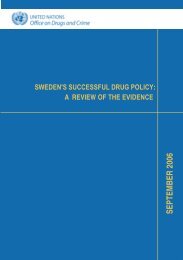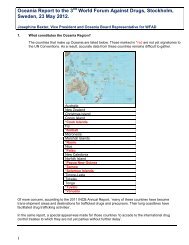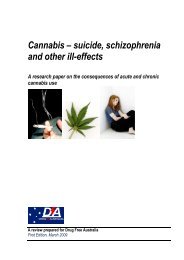International Research Compendium - Drug Free Australia
International Research Compendium - Drug Free Australia
International Research Compendium - Drug Free Australia
Create successful ePaper yourself
Turn your PDF publications into a flip-book with our unique Google optimized e-Paper software.
<strong>Drug</strong>s work in the brain because they have a similar size and shape as natural<br />
neurotransmitters and interact with receptors and other components of the synapse.<br />
<strong>Drug</strong>s masquerade as neurotransmitters and therefore interfere with normal synaptic<br />
transmission by introducing false messages or by changing the strength of real ones.<br />
Disrupting the transmission of information at the synapse is the basic mechanism by<br />
which drugs change behaviour. <strong>Drug</strong>s lock into receptors and start an unnatural<br />
chain reaction of electrical charges, causing neurons to release large amounts of<br />
their own neurotransmitter.<br />
Every type of drug has its own individual mechanism for changing how the brain<br />
functions.<br />
Regardless of which drug a person is addicted to, many of the effects it has on the<br />
brain are similar. Since there is much more dopamine released, there is increased<br />
activation of dopamine receptors. This causes increased production of Cyclic AMP (<br />
Adenosine monophosphate ) inside the post-synaptic cell which alters the normal<br />
activity of the neuron. Cyclic AMP is an intracellular second messenger that can<br />
initiate a wide variety of changes in the postsynaptic cell. Effects of an upregulated<br />
cyclic AMP system have been demonstrated in many of the relevant brain regions<br />
regarding substance use, such as the Nuc. Accumbens and the VTA. Through<br />
upregulation of cyclic AMP, drugs induce a variety of molecular changes in neurons,<br />
thereby remodelling and restructuring neurons. Synaptic plasticity ( the<br />
reorganisation of neural circuitry ) by psychoactive substances can occur via changes<br />
in neurotransmitter release, the status of the neurotransmitter receptors, receptormediated<br />
signalling or the number of ion channels regulating neuronal excitability.<br />
Repeated stimulation of receptors by drugs can lead to alterations in receptor number<br />
and function. Many of the synaptic changes are thought to be mediated by processes<br />
similar to those for learning and memory. There are both presynaptic changes (<br />
increased dopamine release ) and postsynaptic changes ( changes in receptor<br />
sensitivity ).<br />
The result of this process is that drugs change the way the brain works, and that<br />
changes how people perceive the world, how they feel about themselves and their<br />
world, and how they behave. These changes have a huge influence on all aspects of<br />
a person’s behaviour. A drug can become the single most powerful motivator in a<br />
drug abuser’s existence. This does not mean that the addict has no ability to make<br />
choices. But it does mean that the ability to make choices is altered.<br />
<strong>Drug</strong>s teach people to take more drugs<br />
The development of drug addiction can be seen as part of a learning process, in the<br />
sense that enduring changes in behaviour result from interactions with drugs and<br />
drug-related environments. The repetitive, profound stimulation of dopamine<br />
transmission induced by drugs in the Nuc. Accumbens abnormally strengthens drugtaking<br />
behaviour. The powerful memory of early drug experiences is one of the things<br />
that drives users to keep taking drugs.<br />
The huge release of dopamine in response to a reward leads to a strengthening of<br />
the synaptic connections in neural pathways that led to the behaviour that was<br />
associated with the reward.<br />
Structural changes in the synapse of connecting neurons enable people to learn and<br />
retain what they have experienced by using drugs. This reinforces the behaviours<br />
that led to the occurrence of that reward. And the brain becomes more sensitive to<br />
13






